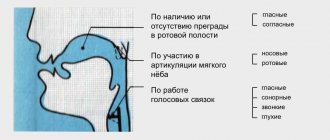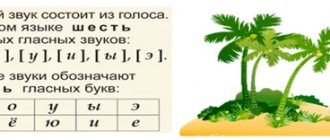The topic of our new lesson is intonation. We already have a sufficient knowledge base to understand it. In previous lessons, we understood how the voice works and how to influence its main characteristics. We also studied in some detail various aspects of correct diction and articulation.
The purpose of the lesson is to learn to intonate and express various emotions using intonation, to reinforce important points in your speech, to indicate the end of one thought and the transition to the next.
We will study different types of intonation and learn how to apply them in practice.
The purpose of the lesson is clear, so let's move on to the lesson.
Intonation is...
It is interesting that until the middle of the last century there was no single definition of the term INTONATION. And each of the famous dictionaries gave its own version .
- So, Dahl in his Explanatory Dictionary spoke about strong vocal stress.
- And in Ozhegov’s “Dictionary of the Russian Language”, several characteristics were discussed at once - the accuracy of the sound of the voice, the manner of pronunciation and vocal techniques to highlight the attitude to a particular event.
- And finally, in the Big Encyclopedic Dictionary the concept of intonation was reduced to a poetic form when the voice rises at the beginning of a line and falls at the end.
But today linguists seem to have agreed among themselves and come to a common definition .
Intonation is a change in the melody, rhythm and volume of our speech, which helps us most clearly express our attitude to a specific issue or focus the interlocutor’s attention on certain details.
The term INTONATION itself has Latin roots. And literally “intonō” can be translated as “ to pronounce loudly .” One small but very important detail follows from this.
Intonation is a concept that is applicable only to colloquial speech and is not used to literary and other texts.
How to train your intonation ability
You can train your ability to intonate with the help of special exercises , which are widely practiced in acting courses and departments. By the way, many of an actor’s skills can be useful to us in ordinary everyday life. The simplest training for intonation is reading poetry out loud with expression. This is simply because the poem always has its own rhythm, so it will be easier for you to control the intonation.
Reading poetry
It is better for Russian-speaking people to start with the poems of Yesenin and Mayakovsky . This will allow you to practice opposite intonations in speech. Yesenin’s romantic poems should be read as if in a chant, and Mayakovsky’s brutal work can be safely “chopped into pieces”, cutting the lines into segments convenient for pronouncing.
Be sure to take a deep breath into the bottom of your lungs, making sure your shoulders don't rise and your sides and belly remain puffed out throughout the stitch. Do not suddenly let out all the air at the very first words of the line - this will harm the clarity of speech. In addition, you may not have enough breath for the entire line, and a pause in an illogical place to get air will ruin the melody of speech and the overall impression of your reading the poem out loud.
After Yesenin and Mayakovsky, you can move on to your favorite authors or those poems that you study in the school course of Russian literature and will have to take (read aloud) for assessment. This training will improve not only your speech, but also your academic performance.
The same advice can be given to people who are working on developing their voice with the goal of learning to sing. Each analysis of a new song should begin by simply reading the song like a poem, i.e. without music, without trying to sing. In principle, any song is poetry set to music, so there shouldn’t be any difficulties.
The next step is to tap out the rhythm while reading the poem. This will allow you to work on intonation comprehensively, training all its aspects, including tempo and rhythm. You can clap your hands, you can beat a rhythm on the table. The main thing is that you catch the feeling of rhythm and don’t lose it again.
Next, you need to complicate the task and try to maintain the found tempo, rhythm and other components of intonation, reading the poem with a pencil in your teeth . Don't tense your jaw, don't clench your teeth - just relax your jaw muscles, place a pencil between your upper and lower teeth and start reading the poem.
Reading texts
Reading texts out loud should begin to be practiced after you have begun to gradually master poetry. The fact is that in a standard text you will not have a hint in the form of a rhyme that will allow you to quickly fit into the tempo and rhythm and find the right intonation. You have to set the intonation yourself , and this, in fact, is the point of the exercise.
Take any text (even from a quantum mechanics textbook) and begin to imitate the intonation of any character or real person: Hamlet, Lieutenant Rzhevsky, Natasha Rostova, Tatyana Larina, TV presenter Andrei Malakhov, comedian Evgeny Petrosyan, online game streamer Glad Valakas, co-host “Let's get married” by Roza Syabitova or the host of the “Live Healthy” project Elena Malysheva.
By the way, about the textbook - this is a very good life hack for young parents who have not yet graduated from university. You can easily read to your baby before bedtime any textbook that you need to complete for the session. Very young children don’t understand the meaning yet, but they catch the intonation perfectly. So, calm down the child if he suddenly starts crying, and you yourself will not fall behind the curriculum due to the addition to the family and the increased amount of troubles associated with it.
Imitation of emotions
And finally, when you have begun to succeed in all the previous exercises , you can take any text that is familiar to you, with which you have worked closely, and read it out loud expressing different emotions. This could be a poem or a song, a story or a textbook on strength of materials, or even any of the tongue twisters that you have previously practiced.
Your task is to portray, while reading, all the basic emotions , such as joy, sadness, anger, surprise, disgust, excitement and others. To control, record yourself on video. For people who are far from the acting profession, the emotions they portray, to their surprise, turn out to be surprisingly similar, and it is almost impossible to distinguish disgust from anger in their performance.
If this is your case, try articulating sounds more actively . If it turns out that you don’t quite understand how to portray this or that emotion that is not typical for you personally, we can only advise you to carefully watch films, go to the theater more often and pay attention to the relationship between facial expressions and the emotions portrayed by the actors. Over time, you will accumulate a good amount of knowledge and can easily reproduce the emotion you need.
By the way, you can try the same approach if you have difficulty with the advice to imitate the intonations of characters from classical literature. If you read more , you will quickly figure out whose intonations you would like to master and learn to imitate. And if you visit the theater more often , you will clearly see and hear how to do this.
We can recommend the book “Sounds and Intonation of Russian Speech” to anyone who would like to delve deeper into theory and practice [E. Bryzgunova, 1977]. There you will find a detailed description of the features of intonation in the Russian language, which will help you understand the deep mechanism of sound formation, speech and intonation.
People familiar with musical literacy can recommend the phonopedic method of voice development, which was developed by the candidate of pedagogical sciences Viktor Emelyanov, who received professional training as an artist and opera singer and completed graduate school at the Gnessin Russian Academy of Music [V. Emelyanov, 2020]. Specific exercises can be found in his recently republished book “Voice Development. Coordination and training" [V. Emelyanov, 2020].
Those wishing to work on English pronunciation can recommend the book Intonation of colloquial English [J. O'Connor, G. Arnold, 1978]. Note that in Russian and English, intonation has certain differences, even when the phrase is translated exactly and other interpretations are impossible:
If you have ambitious plans to become not just a lecturer or presenter, but, for example, an artist or singer, Seth Riggs’ book, which is called “How to Become a Star” [P. Riggs, 2000].
Seth Riggs provided the voice for many famous show business stars: Madonna, Julio Iglesias, Stevie Wonder, Michael Jackson and others. And if you have carefully worked through all the exercises previously recommended in our course, you will be able to do the advanced exercises that Seth Riggs gave to his star students who conquered the whole world.
Be sure to download the audio collection of exercises that comes with the book “How to Become a Star” and which will help you in setting your voice for the stage [S. Riggs, 2000]. And pay attention to this point : when it comes to the so-called speech position, we mean the position of the organs of articulation that is characteristic of English speech, and not of Russian, although the book has been translated into Russian. Don't let this nuance confuse you!
Let's summarize. In today's lesson we studied different types of intonation and understood how to apply them in practice. In addition, we figured out how to correctly intonate and express various emotions using intonation, and reinforce important points in our speech. All you have to do is check how you understood the lesson, and you can move on to the next one!
Examples
Well, for example, take the famous poem by Agnia Barto:
Our Tanya is crying loudly, She dropped a ball into the river.
In the written version, it is read in one breath and without intonation stress. In practice, this is simply a statement of the fact that “a certain girl Tanya is crying loudly because she dropped the ball.”
But it’s a completely different matter when we start telling this poem to our children. An expression and intonation will appear. Most often, the voice will rise with the words “crying” and “dropped”:
Our Tanya CRYING loudly DROPPED a ball into the river.
Or you can change the stressed word, for example, in the second line and you’ll get a different meaning:
Dropped a ball into the RIVER (where?) or Dropped a BALL into the river (what?)
And this is what we do every day when communicating with family, friends or work colleagues. With the help of intonation we give our words a certain emphasis. And accordingly, we help others understand us better.
Functions
Voice intonation is a set of speech objects. They combine, alternate and change as necessary. The more diverse the speech, the more informative it is - artificial phrases are used that enhance the manner of speech.
Intonation is necessary for:
separation of phrases or dialogue;
- to separate information and make it clearer;
- used to create the correct structure (in the design of phrases of all types);
- to describe emotions and the general message;
- to separate lexical elements in a phrase.
A certain manner of speech is used for the modality of the text. It helps to build the narrative in the correct form and not get lost in meaningless text.
In speech, you can do without intonation, but with its help it is easier to make the necessary accents: this is useful for artistic speech, for conducting a constructive dialogue. If you do not use intonation, it is difficult to avoid mistakes in communicating with your interlocutor.
Types of intonation
All intonations are divided into three large categories:
- Narrative;
- Exclamation;
- Interrogative.
Narrative intonation
This intonation is used when you simply need to convey some information to your interlocutor. As a rule, several words that the speaker wants to emphasize are stressed.
The weather was GOOD in the morning, and we decided to go to the park. Mom cooked us a CHOCK for dinner. The refrigerator is EMPTY, so we need to go to the store.
Narrative speech is also characterized by a decrease in intonation at the end of each sentence. Thus, a person unconsciously separates one sentence from another.
Question intonation
Interrogative intonation accompanies any question that is addressed to the interlocutor. And she definitely makes it clear that the person wants an answer.
Why didn't you do your homework?
In this case, the question word is “why.” This is where the vocal stress comes in. But intonation can highlight absolutely any word in an interrogative sentence. And this will change the question itself.
Are you GOING to go to the sea next summer? Are you going to go to the sea next summer? Are you going to go to the sea NEXT summer? (or this) Are you going to go to the sea next SUMMER? (either autumn or spring) Are you going to GO to the sea next summer? (or fly) Are you going to go TO THE SEA next summer? (or to the mountains, or to Europe)
You see, there is one sentence, but intonationally you can turn it into six different questions. And each one has its own answer, different from the others.
Exclamatory intonation
Exclamatory intonation is a way to express your emotions, both positive and negative. As a rule, we are talking about increasing the strength of the voice. Loud speech always attracts attention.
How BEAUTIFUL it is tonight! I am so TIRED of this job. I give you the LAST chance!
As you can see, very often exclamatory sentences end with an exclamation mark.
Compound
Any phrase has its own intonation: regardless of the message of emotion and its volume. Even neutral phrases have a certain tone that demonstrates the overall meaning. The manner of speech consists of the following elements:
- frequency;
- intensity;
- pauses;
- melody.
Frequency and saturation are the objects of speech that first show the general message. Depending on the changing mood, the tonality changes: one phrase can combine several different speech structures at once (act as an accent, narration). A feeling, an emotion, a strong experience influences the sound of the voice.
Intensity is the 2nd indicator of emotions. It depends on the functioning of the facial muscles. The direction of the muscles creates different intensities of speech: there is a change in tone and its duration.
The meaning of intonation implies the presence of pauses. They help highlight individual phrases - this is how emphasis is placed. Thanks to pauses, speech becomes more meaningful and structured. Expressive pauses are stops in monotonous speech (they cannot be made too long). To demonstrate emotions in speech, melody is used: the movement of tone (its rise and fall).
What are some suggestions for intonation?
Based on intonation, sentences are divided into:
- Exclamations are filled with emotions; they express the feelings of those who write or speak.
And most often this is associated with admiration, although not necessarily. Look how bright the stars are in the sky. Mom, the soup is very tasty. - Non-exclamatory ones are a simple statement of fact.
It is pronounced calmly, without much emotion. Night fell and the stars began to shine outside the window. Mom prepared a very tasty soup.
If you remember what kinds of sentences there are according to the purpose of statements, then adding them with intonation options we get the following picture:
Stages of effective analysis of a poem or text fragment
- Comprehensive familiarization with the content of the text, comprehension of the author's intention: – expressive reading by the teacher of the text ( no assignments before the first reading! ); – independent reading of students, identification of individual events and parts of the text (title or quotation plan); – creating a chain of visions and associations associated with the aesthetic perception of the content of the text (working with key concepts, questions on text analysis, working with figurative means of language); – clarification of the main thought, idea of the work.
- Formulating the main purpose of reading, a cross-cutting action for the entire text.
- Performing task for each part of the text. – Analysis of the text, result of the analysis: the main idea – A.S. Pushkin loves both early autumn, the time of farewell beauty, when “the forests are dressed in crimson and gold,” and late autumn, when “a rare ray of sunshine” flashes, when “threats distant from the gray winter are felt” in nature. (You can write this text as a sample with partial citation, which is used in literary analysis of works). – The main purpose of reading, the cross-cutting action, is to convey the author’s love for both early and late autumn. – Performing task for each part: the first part is admiration for early autumn, the second part is slight sadness. – Intonation (mark).
Important properties
The linguistic terms of intonation are associated with the demonstration of emotions through the creation of certain structures. The melody conveys joy, hatred, sympathy. This style does not have an exact meaning, but there are basic motives. Rhythmic-melodic intonation can convey a person’s character, his behavior, and motives. Melody is a means of expressing a sensual tone that is difficult to describe in words.
Correct accents
The most important part of manner is emphasis. It can show the semantic message of a statement. The accent serves to highlight individual words and their correct interpretation. The correct accent is logical and syntagmatic.
Tactic emphasis distinguishes individual parts of the structure from the speech stream. Meaningful groups increase overall meaning. Logical accents reinforce only important words, for the sake of which the entire speech is structured. In the intonation type of phrase, additional pauses are used after the accent.










